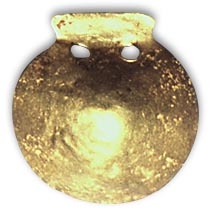- Home
- Time and place
- From the Neolithic to The Chalcolithic in Dobrogea
- Gumelnita Culture
Model of a temple (?) terra cotta (origin : Cascioarele, district : Calarasi).
Eponym Site : The Gumelnita (Romanian) tell is located near the left bank of the Danube.
Dates : Beginning of the Chacolithic (also called the Eneolithic) in Romania, toward the beginning of the fifth millennium. Divided into two periods, referred to simply as A and B, and lasting just short of a millennium.
Geographic Setting : A vast expansion from the coast of the Black Sea in the east to central Bulgaria in the west, from the Danube delta in the north to the Greek Thrace in the south.
Habitation : Most often "Tell" type settlements, sometimes surrounded by defensive walls.
Material Means : A great variety of ceramics decorated with carvings, moldings, barbotine or paints, most notably graphite. Tools of bone or elk antlers are plentiful.
Figurative ceramic models probably Gumelnita dwellings (lower image, origin : Aldeni ; above, origin : Fîntînele).
Gold idol, Gumelnita culture (origin : Vârâsti).
The site is found 5 kilometers form Oltenita on the Danube plateau. The Gumelnita culture actually belongs to an important cultural group called "Gumelnita-Karanovo VI-Kodjadermen" which resulted from the first great cultural synthesis, which occurred between the southern Balkans (Dikili Tash, Sitagori...) and the Carpathians. Within this conglomeration of cultures appeared some local particularities. They are often difficult to distinguish and difficult to explain, but are undoubtedly related to the heritage of the preexistent cultures, the Necropolis of Varna (Bulgaria) is the most eloquent example.
The cultural aggregate "Gumelnita-Karanovo VI-Kodjadermen" was born of the evolution of the Boian, Marita and Karanovo V cultures. This phenomenon occurred so rapidly that from its origin it can be referred to as a unique culture with regional attributes. In the A2 period of the Gumelnita culture, the cultural unification becomes even more evident, as the styles and shapes in ceramics and statuary become practically identical.
The principle settlements are tells (Karanovo, Harsova, Bordusani...) and it is the stratigraphy, which gives us the greatest amount of information on the chronological evolution of both this culture and its relation to the neighboring cultures (Vinca, Cucuteni, Dimini, Salcuta). The Necropolis at Varna is an important site in understanding this culture. The impressive richness of the tombs discovered there made it possible to recognize a powerful hierarchal social organization.
The evolution of the "Gumelnita-Karanovo VI-Kodjadermen" gradually comes to completion with the arrival of the Cernavoda I tribes on the Danube, who are considered by a number of researchers as the first proto-Europeans. Even as the evolution of the Gumelnita culture finishes abruptly with the A2 period, it continues in other zones (Munteny, Thrace, Balkans) for at least a century with Gumelnita phase B.


